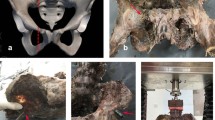Abstract
Purpose
Diastasis of the sacroiliac joint after pelvic ring injury is commonly reduced by lagging by design with partially threaded (PT) screws. There may be a biomechanical benefit to lagging by technique with fully threaded (FT) screws. The purpose of this study was to compare these two methods.
Methods
Twelve pairs of synthetic bone blocks were lagged together with 8.0-mm FT or PT screws. Maximum compressive and steady-state force was measured. Pullout force testing was performed.
Results
The maximum compressive force of FT and PT screws was not different [mean difference (MD) 32 Newtons (N), 95% confidence interval (CI) 124, 60)]; however, lagging by technique with FT screws resulted in significantly higher steady-state force (MD 83 N, 95% CI 165, 5) and pullout force (MD 634 N, 95% CI 778, 491).
Conclusion
Lagging by technique with large diameter FT screws has a biomechanical advantage over lagging by design with PT screws.




Similar content being viewed by others
References
Routt MLC (1997) Iliosacral screw fixation: early complications of the percutaneous technique. J Orthop Trauma 11(8):584–589
Pollard JD, Deyhim A, Rigby RB et al (2010) Comparison of pullout strength between 3.5-mm fully threaded, bicortical screws and 4.0-mm partially threaded, cancellous screws in the fixation of medial malleolar fractures. J Foot Ankle Surg. 49(3):248–252
Downey MW, Kosmopoulos V, Carpenter BB (2015) Fully threaded versus partially threaded screws: determining shear in cancellous bone fixation. J Foot Ankle Surg. 54(6):1021–1024
Ricci WM, Tornetta P, Borrelli J (2012) Lag screw fixation of medial malleolar fractures: a biomechanical, radiographic, and clinical comparison of unicortical partially threaded lag screws and bicortical fully threaded lag screws. J Orthop Trauma 26(10):602–606
Zhang QH, Tan SH, Chou SM (2004) Investigation of fixation screw pull-out strength on human spine. J Biomech 37(4):479–485
Decoster TA, Heetderks DB, Downey DJ et al (1990) Optimizing bone screw pullout force. J Orthop Trauma 4(2):169–174
Dragoni M, Heiner AD, Costa S et al (2012) Biomechanical study of 16-mm threaded, 32-mm threaded, and fully threaded SCFE screw fixation. J Pediatr Orthop 32(1):70–74
Kraemer W, Hearn T, Tile M et al (1994) The effect of thread length and location on extraction strengths of iliosacral lag screws. Injury 25(1):5–9
Funding
This research did not receive any specific grant from funding agencies in the public, commercial or not-for-profit sectors.
Author information
Authors and Affiliations
Contributions
All authors made contributions to the conception and design of the study, acquisition of data, analysis and interpretation of data and drafting the article or revising it, and gave final approval of the submitted version.
Corresponding author
Ethics declarations
Conflict of interest
Cyril Mauffrey has the following disclosures: Abbott: other financial or material support; Carbofix: research support; Current Opinion in Orthopaedics: editorial or governing board, DePuy; A Johnson & Johnson Company: other financial or material support; International Orthopaedics: editorial or governing board; La Societe Internationale de Chirurgie Orthopedique et de Traumatologie: board or committee member; Orthopaedic Trauma Association: board or committee member; OsteoMed: research support; Patient safety in surgery: editorial or governing board; Springer: publishing royalties, financial or material support; Stryker: paid consultant and unpaid consultant; The European Journal of Orthopaedic Surgery and Traumatology: Editorial or governing board. Joshua Parry has the following disclosures: The European Journal of Orthopaedic Surgery and Traumatology: editorial or governing board. The remaining authors have nothing to disclose.
Additional information
Publisher's Note
Springer Nature remains neutral with regard to jurisdictional claims in published maps and institutional affiliations.
Rights and permissions
About this article
Cite this article
Maher, M., Baldini, T.H., Parry, J.A. et al. The potential biomechanical advantage of lag by technique screw fixation of the posterior pelvic ring. Eur J Orthop Surg Traumatol 30, 1045–1048 (2020). https://doi.org/10.1007/s00590-020-02665-8
Received:
Accepted:
Published:
Issue Date:
DOI: https://doi.org/10.1007/s00590-020-02665-8




